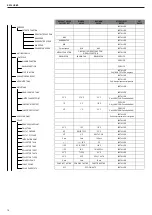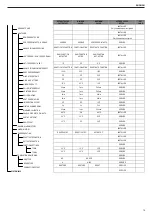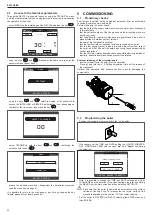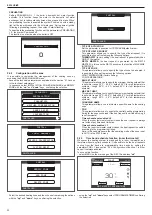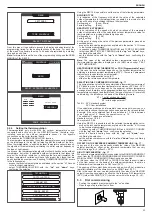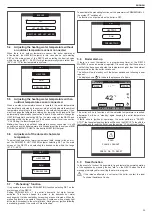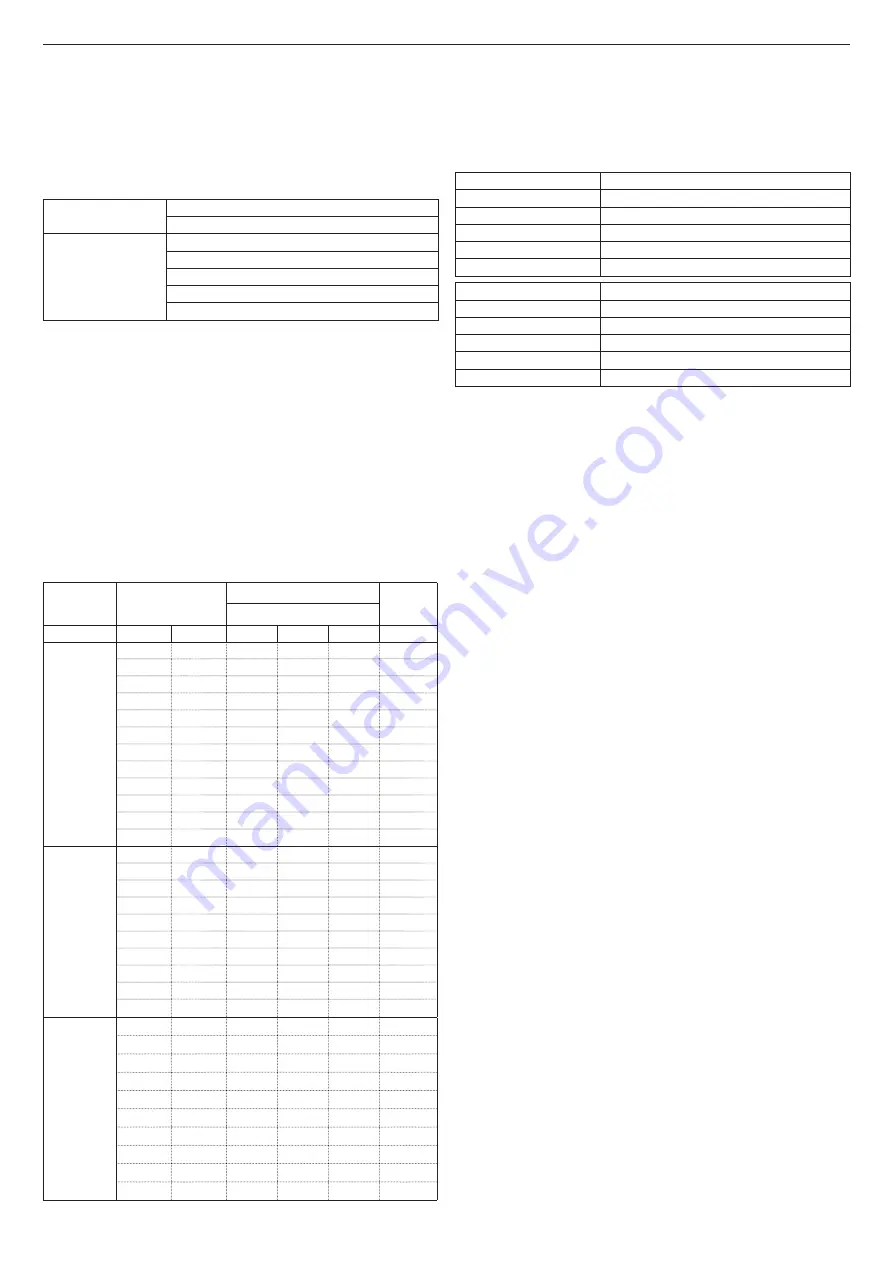
12
EXCLUSIVE
Twin pipes ø 80 with ducting Ø50 - Ø60 - Ø80 (fig. 15a)
Thanks to the boiler characteristics, a flue gas discharge pipe ø 80 can
be connected to the ducting ranges Ø50 - Ø60 - Ø80.
b
For the ducting, you are advised to make a project calculation in
order to respect the relevant standards in force.
The table shows the standard configurations allowed.
Table of standard pipe configurations (*)
Air suction
1 bend 90° ø 80
4,5m pipe ø 80
Flue gas discharge
1 bend 90° ø 80
4,5m pipe ø 80
Reduction from ø 80 to ø50, from ø 80 to ø 60
Stack base bend 90°, ø 50 or ø 60 or ø 80
For ducting pipe lengths see table
(*) Use flue gas system accessories in plastic (PP) for condensing boilers:
Ø50 and Ø80 H1 class and Ø60 P1 class.
The boilers are factory set to:
25C:
5.600 r.p.m. (CH) and 7.900 r.p.m. (DHW) and the maximum length
that can be reached is 6m for the ø 50 pipe, 21m for the ø 60 pipe and 115m
for the ø 80 pipe.
30C:
6.500 r.p.m. (CH) and 7.900 r.p.m. (DHW) and the maximum length
that can be reached is 4m for the ø 50 pipe, 16m for the ø60 pipe and 83m
for the ø 80 pipe.
35C:
6.900 r.p.m. (CH) and 7.800 r.p.m. (DHW) and the maximum length
that can be reached is 1m for the ø 50 pipe, 10m for the ø60 pipe and 54m
for the ø 80 pipe.
Should it be necessary to achieve greater lengths, compensate the pressure
drop with an increase in the r.p.m.of the fan, as shown in the adjustments
table, to ensure the rated heat input.
b
The minimum calibration is not modified.
Adjustments table
Maximum number
of fan rotations
r.p.m.
Ducting pipes
ΔP at
boiler
output
maximum length (m)
CH
DHW
Ø 50
Ø 60
Ø 80
Pa
25C
5.600
7.900
6
21
115
180
5.600
8.000
8 (*)
25 (*)
139 (*)
210
5.700
8.100
10 (*)
32 (*)
175 (*)
255
5.700
8.200
12 (*)
35 (*)
195 (*)
280
5.800
8.300
14 (*)
42 (*)
231 (*)
325
5.900
8.400
17 (*)
48 (*)
263 (*)
365
6.000
8.500
19 (*)
53 (*)
291 (*)
400
6.100
8.600
22 (*)
60 (*)
331 (*)
450
6.200
8.700
24 (*)
66 (*)
363 (*)
490
6.200
8.800
26 (*)
71 (*)
389 (*)
523
6.300
8.900
28 (*)
76 (*)
420 (*)
562
6.400
9.000
31 (*)
82 (*)
452 (*)
601
30C
6.500
7.900
4
16
83
190
6.600
8.000
5 (*)
19 (*)
103 (*)
225
6.700
8.100
7 (*)
24 (*)
128 (*)
270
6.800
8.200
9 (*)
28 (*)
151 (*)
310
6.900
8.300
11 (*)
33 (*)
174 (*)
350
7.000
8.400
13 (*)
37 (*)
196 (*)
390
7.100
8.500
14 (*)
40 (*)
213 (*)
420
7.200
8.600
16 (*)
44 (*)
236 (*)
460
7.300
8.700
17 (*)
48 (*)
256 (*)
495
7.400
8.800
19 (*)
53 (*)
281 (*)
540
35C
6.900
7.800
1
10
54
161
7.000
7.900
2
12
68
190
7.100
8.000
3 (*)
16 (*)
86 (*)
225
7.200
8.100
4 (*)
18 (*)
101 (*)
255
7.300
8.200
6 (*)
23 (*)
124 (*)
300
7.400
8.300
7 (*)
25 (*)
140 (*)
330
7.500
8.400
10 (*)
32 (*)
175 (*)
400
7.600
8.500
11 (*)
35 (*)
191 (*)
430
7.700
8.600
13 (*)
39 (*)
216 (*)
480
7.800
8.700
14 (*)
42 (*)
231 (*)
510
(*) Maximum installable length ONLY with exhaust pipes in H1 class.
Configurations Ø50 or Ø60 or Ø80 show test data verified in the laboratory.
In the case of installations that differ from those indicated in the “standard
configuration” and “adjustments” tables, refer to the equivalent linear
lengths below.
b
In any case, the maximum lengths declared in the booklet are
guaranteed, and it is essential not to exceed them.
COMPONENT Ø 50
Linear equivalent in metres Ø80 (m)
Bend 45° Ø 50
12,3
Bend 90° Ø 50
19,6
Extension 0.5m Ø 50
6,1
Extension 1.0m Ø 50
13,5
Extension 2.0m Ø 50
29,5
COMPONENT Ø 60
Linear equivalent in metres Ø80 (m)
Bend 45° Ø 60
5
Bend 90° Ø 60
8
Extension 0.5m Ø 60
2,5
Extension 1.0m Ø 60
5,5
Extension 2.0m Ø 60
12
3.9 Filling the heating system (fig. 16)
Note:
even if the boiler is fitted with a semi-automatic filling device, the
first filling operation must be carried out by turning the filler tap (
B
) with the
boiler off.
Once the hydraulic connections have been carried out, fill the heating
system. This operation must be carried out when the system is cold,carrying
out the following operations:
- open the caps of the lower (
A
) automatic air vent valve by two or three
turns; to allow a continuous venting of the air, leave the plug of the valve
A
open
- make sure the cold water inlet tap is open
- open the filling tap (
B
) until the pressure indicated by the water pressure
gauge is between 1 and 1.5 bar
- re-close the filling tap.
b
The venting of the boiler takes place automatically via the two
automatic vent valve
A
positioned on the circulator.
3.10 Draining the heating system (fig. 16)
Before starting emptying, switch off the electricity supply by turning off the
main switch of the system.
- Close the heating system’s valves.
- Connect a hose to the system drain valve (
C
).
- Manually loosen the system drain valve (
C
).
3.11 Emptying the domestic hot water system
Whenever there is risk of frost, the domestic hot water system must be
emptied in the following way:
- turn off the main water supply tap
- turn on all the hot and cold water taps
- drain the lowest points.
3.12 Circulator settings
Circulator residual discharge head
The boilers is equipped with an already hydraulically and electrically
connected circulator, whose useful available performance is indicated in
the graphs at page 42.
The circulator comes set from the factory with a 6 metre discharge head curve.
The boiler is equipped with an anti-blocking system which starts up an
operation cycle after every 24 hours in standby with the mode selector in
any position.
b
The “antiblocking” function is active only if the boiler is electrically
powered.
a
Operating the circulator without water is strictly forbidden.
If you need to use a different curve you can select the desired level on the
circulator.
Below the main characteristics and the ways to set up their desired operation
are listed.
3.12.1 User interface
The user interface is made up of a button (
A
), a two-coloured red / green
LED (
B
) and four yellow LEDs (
C
) arranged in a row.
Summary of Contents for EXCLUSIVE C
Page 101: ... ...


















